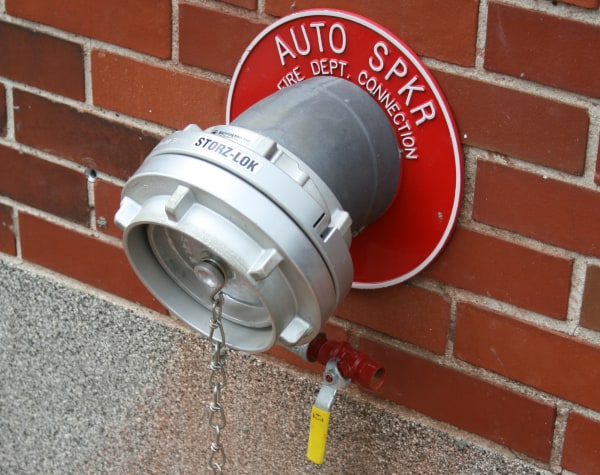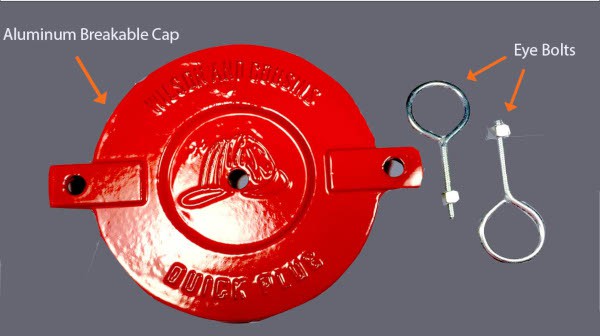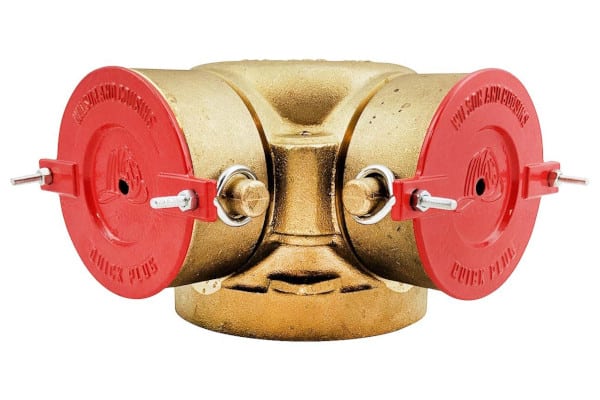FDC caps offer a cost-effective and easily installed alternative to traditional plugs
Blockages in a fire department connection can prove catastrophic for buildings and the people in them. If firefighters can’t supply water to a building’s fire protection system, sprinklers may stop spraying, hoses run dry, and fire spreads.
In this article, we look at how to protect these life-saving inlets with FDC caps. We touch on the function of FDCs and caps, explain when caps may be preferred over plugs, and describe how to install FDC caps in just a few short steps.
If you need to start browsing for an FDC cap right away, view our selection of breakable FDC caps.
FDC caps protect inlets used to supply water to fire sprinkler and standpipe systems at critical moments
A building’s fire department connection (FDC) is the access point where fire engines and tankers provid water to fire sprinkler or standpipe systems in an emergency.
FDC caps cover a building’s fire department connection (FDC) and prevent foreign material from entering. Dust, debris, garbage, and other substances can make it difficult or impossible for firefighters to connect hoses or pump water at the right pressure. By keeping the connecting lines unclogged and free of contamination, these caps ensure full flow to a building’s fire protection system.
Before detailing these caps any further, it’s important to note that FDCs fall into one of two categories: those designed for threaded hose connections and those made to secure Storz connections. While either plugs or caps can protect threaded FDCs, threadless Storz FDCs only utilize specific Storz caps (sometimes also called plugs). Breakable caps, then, only work with traditional threaded FDCs.

Breakable FDC caps can either be plastic or aluminum, and they attach to the lugs of a fire department connection’s swivel—the mechanism that connects to a fire hose—using eye bolts and nuts. These caps allow firefighters to act fast—they can be broken off instantly with the blow of an ax or another heavy object.
The alternative—a threaded plug—must be unscrewed from the swivel. Such plugs come standard with the purchase of most fire department connections and offer greater durability than caps. However, for reasons we’ll discuss below, they can be a source of headaches for some building owners and firefighters.
Want to learn more about the difference between plugs and caps? Click here.
The right size FDC cap can provide a cost-effective alternative to traditional plugs
Theft is the most common reason our customers replace plugs with FDC caps. In many instances, both the plug and FDC consist of brass and, unfortunately, often become stolen for their scrap value. Fire department connections, specifically, can cost businesses roughly $500-$1500 to replace (even though their value at a scrapyard amounts to a measly $20-$25). Breakable caps, on the other hand, deter theft by using materials with little to no scrap value, like plastic or aluminum. That said, there are also aluminum plugs that discerning metal thieves may avoid taking.
Most buildings require 2 1/2″ caps. Critically, 2 1/2″ measures the inner diameter of the inlet and not the diameter of the outer ring or swivel. Taking measurements from the outside of the swivel will result in readings that can be as much as an inch larger than the desired size. Unfortunately, many of our customers often purchase 3″ caps because they use the outer diameter of their FDC as the reference for size—a size used only in a handful of jurisdictions, such as New York City, New York and San Francisco, California.
If you’re not sure how to measure, don’t fret: read our article on what size of FDC cap or plug you need.
FDC caps install in three simple steps
To replace a brass plug with a cap—or protect an inlet that’s been left exposed—no special tools are needed.

Follow these steps to install an FDC cap:
- If your FDC contains a plug, rotate it inside the swivel until completely unthreaded. If the FDC has no plug, skip to step 2.
- Place the bolts through the holes in the cap with the eyes on the reverse-facing side of the cap. When properly placed, the bolts should stick out on the side with the manufacturer’s text and symbol.
- Slide the eyes over the FDC’s lugs. Tighten the nuts onto the bolts to securely install the FDC cap on the swivel.
QRFS has plastic and aluminum FDC caps at great prices
FDC caps are a useful and cost-efficient way to ensure the performance of a building’s fire department connection. Both plastic and aluminum caps work well, although aluminum adds durability with only a slight increase in cost.
QRFS proudly carries plastic and aluminum breakable caps for standard 2 1/2″ FDCs as well as 3″ caps for the San Francisco and New York markets. Each breakable cap is designed for ease of installation and removal and sold in sets of two to cover both inlets on the most standard FDC type: the Siamese, or double-inlet FDC.

Click here to view our selection of breakable FDC caps.
Questions about this article or our product line? Call us at (888) 361-6662 or email support@qrfs.com.
This blog was originally posted by Jason Hugo and Cameron Sharp at blog.qrfs.com on May 27, 2016, and updated on February 7, 2022. If this article helped you with your FDC caps, check us out at Facebook.com/QuickResponseFireSupply or on Twitter @QuickResponseFS.


